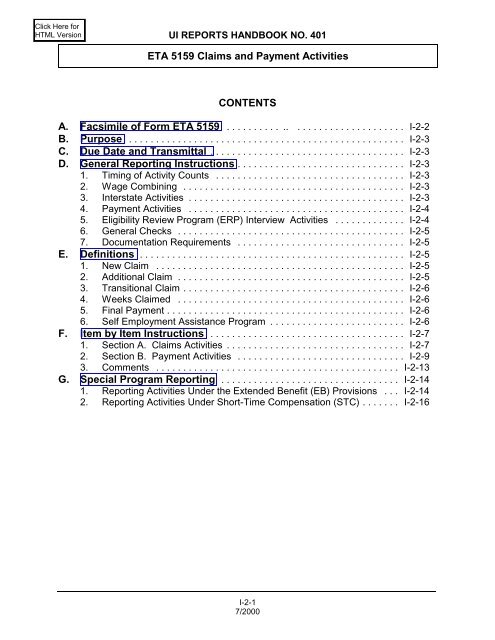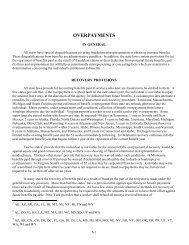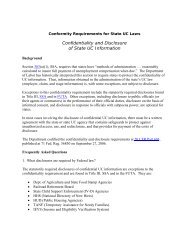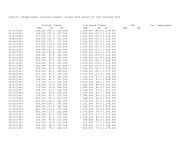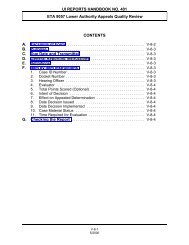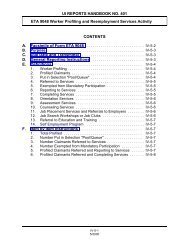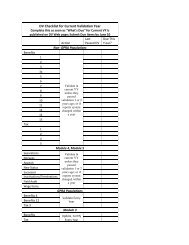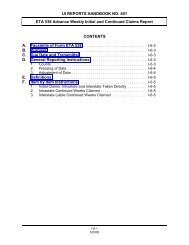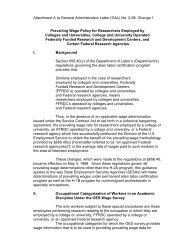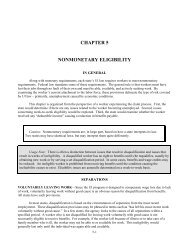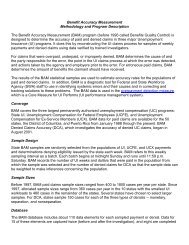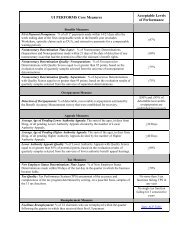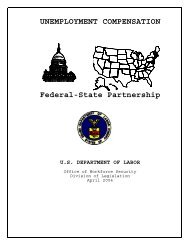ETA 5159 Claims and Payment Activities - Unemployment Insurance
ETA 5159 Claims and Payment Activities - Unemployment Insurance
ETA 5159 Claims and Payment Activities - Unemployment Insurance
Create successful ePaper yourself
Turn your PDF publications into a flip-book with our unique Google optimized e-Paper software.
UI REPORTS HANDBOOK NO. 401<strong>ETA</strong> <strong>5159</strong> <strong>Claims</strong> <strong>and</strong> <strong>Payment</strong> <strong>Activities</strong>A. Facsimile of Form<strong>ETA</strong> <strong>5159</strong> - CLAIMS AND PAYMENT ACTIVITIES OMB Approval No 1205-0010Expires:3/31/2003REPORT FOR PERIOD ENDING: STATE: REGION:SECTION A. <strong>Claims</strong> <strong>Activities</strong>Initial <strong>Claims</strong>ProgramLineNo.Total Sum ofCols. 2-4(1)New IntrastateExcludingTransitional(2)AdditionalIntrastate(3)InterstateFiled fromAgent State(4)InterstateTaken asAgent State(5)Transitional(6)InterstateReceived asLiable State(7)State UI 101UCFE, No UI 102UCX Only 103Intrastate(8)Eligibility ReviewsInterstateLiable(9)Intrastate(10)Continued Weeks ClaimedInterstate Filed fromAgent State(11)Interstate Receivedas Liable State(12)Entering SelfEmployment,All Programs(13)State UI 201UCFE, No UI 202UCX Only 203SECTION B. <strong>Payment</strong> <strong>Activities</strong>Weeks <strong>and</strong> Amounts CompensatedItemsNumber 301All WeeksCompensated(14)State UI Program UCFE <strong>and</strong> UCX Programs SelfTotal <strong>Unemployment</strong>(15)Interstate(16)Total(17)UCFE, No UI(18)UCX Only(19)Employment,AllPrograms(20)Amount 302First <strong>Payment</strong>s for All <strong>Unemployment</strong>Final <strong>Payment</strong>s for All <strong>Unemployment</strong>State UI ProgramUCFE & UCX ProgramsState UIProgramUCFE & UCX ProgramsTotal(21)Intrastate(22)Interstate(23)UCFE, No UI(24)UCX Only(25)Total(26)UCFE, NoUI(27)UCX Only(28)Number 303CommentsThese reporting requirements are approved by the Office of Management <strong>and</strong> Budget under the PaperworkReduction Act of 1995, OMB Approval No. 1205-0010, expiration date 3/31/2003. Persons are not requiredto respond to this collection of information unless it displays a currently valid OMB control number.Respondents obligation to reply to these reporting requirements are M<strong>and</strong>atory (SSA 303(a)(6)). Publicreporting burden for this collection of information is estimated to average 1-2 hours per response, includingthe time for reviewing instructions, searching existing data sources, gathering <strong>and</strong> maintaining the dataneeded, <strong>and</strong> completing <strong>and</strong> reviewing the collection of information. Send comments regarding this burdenestimate or any other aspect of this collection of information, including suggestions for reducing this burdento the U.S. Department of Labor, <strong>Unemployment</strong> <strong>Insurance</strong> Service, Room S-4231, 200 ConstitutionAvenue, N.W. Washington, D.C. 20210.I-2-27/2000
UI REPORTS HANDBOOK NO. 401<strong>ETA</strong> <strong>5159</strong> <strong>Claims</strong> <strong>and</strong> <strong>Payment</strong> <strong>Activities</strong>B. Purpose.The <strong>ETA</strong> <strong>5159</strong> report contains monthly information on claims activities <strong>and</strong> on thenumber <strong>and</strong> amount of payments under State unemployment insurance laws (StateUI) <strong>and</strong> Federal unemployment insurance laws for Federal workers (UCFE) <strong>and</strong> forex-service members (UCX). These data are used in budgetary <strong>and</strong> administrativeplanning, program evaluation, <strong>and</strong> reports to Congress <strong>and</strong> the public. There areseparate <strong>ETA</strong> <strong>5159</strong> reports labeled Regular, Extended Benefits (EB), <strong>and</strong> Short TimeCompensation (STC), also known as Workshare, that furnish data on selected claims<strong>and</strong> benefit activities. Activity for claimants in the Self Employment Assistanceprogram are to be included in the regular counts of the <strong>ETA</strong> <strong>5159</strong> as well as shownin a break out on the regular report.C. Due Date <strong>and</strong> Transmittal.The report is due in the <strong>ETA</strong> National Office on the 15th day of the month followingeach calendar month to which it relates. The regular, EB, <strong>and</strong> STC versions of thisreport will be transmitted electronically.D. General Reporting Instructions.1. Timing of Activity Counts. Count activities as of the date they occur. Thus,initial claims <strong>and</strong> continued weeks claimed are counted as of the date the claimsare taken or received. Count payments <strong>and</strong> weeks compensated as of the datepayments are made; in-person, mailed, or electronically deposited. When thereare split weeks where part of the week's activity falls in one month <strong>and</strong> part inanother, the activity for the part of the week in the reference month should becounted if possible. If this daily activity cannot be separated, use one-fifth (1/5)of the week's activity for each weekday in the reference month as an acceptablealternative. Use one-fourth (1/4) if the week contains a legal holiday.2. Combined Wage Claim (CWC) Activity. <strong>Claims</strong> taken <strong>and</strong> payment made underthe Interstate Arrangement for Combining Employment <strong>and</strong> Wages are reportedas either intrastate or interstate <strong>and</strong> are reported only by the paying (liable)State. Report under intrastate activities any CWCs filed in the paying State,including CWCs filed by commuters whether in-person or through remote claimsfiling procedures. Report under interstate activities CWCs received from anagent State or, interstate, CWCs filed directly with the paying State throughliable State remote claims filing procedures.3. Interstate <strong>Activities</strong>. In Section A, both agent <strong>and</strong> liable State initial claims <strong>and</strong>continued weeks claimed activities are reported. (Report separately for StateUI, UCFE, <strong>and</strong> UCX programs.) For workload purposes, as the agent State,I-2-37/2000
UI REPORTS HANDBOOK NO. 401<strong>ETA</strong> <strong>5159</strong> <strong>Claims</strong> <strong>and</strong> <strong>Payment</strong> <strong>Activities</strong>report the total of all interstate initial claims <strong>and</strong> weeks claimed filed from theState, whether filed through the facility of the agent State or directly with theliable State. Separately, as the agent State, report all initial claims <strong>and</strong> weeksclaimed actually taken by the agent State. Note: For agent State reportingpurposes, interstate initial claims include new, additional, transitional <strong>and</strong>reopened claims. <strong>Claims</strong> filed by commuters, in person, by mail, telephone orby other means, directly with the liable State are reportable as intrastate claims.<strong>Claims</strong> filed through the facilities of the agent state are reportable as interstateclaims. In Section B, the reporting of interstate claims <strong>and</strong> payment activities isrestricted to reporting activities of the liable State.4. <strong>Payment</strong> <strong>Activities</strong>. To count weeks compensated, analyze payments for morethan one week of unemployment to determine the number of weeks ofunemployment to which such payments relate.In States where the maximum duration of regular UI benefits is more than 26weeks, include on the regular report those sharable regular weeks over 26 upto the State maximum payable during an extended benefit period. Report theportion of sharable regular benefit payments subject to Federal Governmentreimbursement under the Federal/State Extended Compensation program as ifit were State UI benefit payments. Thus, both the State <strong>and</strong> Federal portions ofsharable regular benefit payments are included in line 302 of the regular report.Do not report data for sharable regular weeks separately on this report; however,report amount paid for such weeks on the <strong>ETA</strong> 2112.5. Eligibility Review Program (ERP) Interview <strong>Activities</strong>. The ERP is designed toaccelerate the claimant’s return to work <strong>and</strong> systematically review the claimant’sefforts toward that goal.ERP interviews are reported under regular unemployment compensationprograms: State UI, UCFE, <strong>and</strong> UCX by intrastate <strong>and</strong> by liable interstateactivity. Similar data are reportable when applicable under the Federal/StateExtended Compensation program (EB).ERP interviewers select <strong>and</strong> interview UI claimants based on information inEligibility Review Forms. This form includes eligibility-availability informationfrom the claimant indicating his/her proposed search for work. The form alsoprovides a section for the ERP interviewer's comments. The first ERP interviewis scheduled if the claimant is in a dem<strong>and</strong> occupation <strong>and</strong> still unemployed, ifthe claimant appears to need help in finding work, or if the claimant's benefiteligibility is suspect.The ERP interview differs from the "Periodic Interview" in that the claimant'scharacteristics are assessed as they relate to current local labor marketI-2-47/2000
UI REPORTS HANDBOOK NO. 401<strong>ETA</strong> <strong>5159</strong> <strong>Claims</strong> <strong>and</strong> <strong>Payment</strong> <strong>Activities</strong>conditions rather than to passage of time. Following are reasons for schedulingERP interviews:! a claimant with a firm short-term layoff does not return to work by theexpected date;! a claimant expected to return to work upon occurrence of some event, e.g.,seasonal weather change, procurement of equipment, does not return towork;! a claimant scheduled for interview after a nonmonetary issue is resolved;! a claimant whose ERP questionnaire raises questions on his/her availabilityfor full-time work.6. General Checks. Entries should be made for all required items. If the item isinapplicable or if applicable but no activity corresponding to the items occurredduring the report period, a zero should be entered. A report containing missingdata can not be sent to the National Office but can be stored on the State'ssystem. Edit checks can be found in H<strong>and</strong>book 402, <strong>Unemployment</strong> <strong>Insurance</strong>Required Reports User’s Manual, Appendix C.7. Documentation Requirements. A record of each workload item on the <strong>ETA</strong><strong>5159</strong>, new claims, additional claims <strong>and</strong> weeks claimed, must be maintained ineither a manual or computer file <strong>and</strong> be accessible for validation.E. Definitions.1. New Claim. The first initial claim filed in person, by mail, telephone or othermeans to request a determination of entitlement to <strong>and</strong> eligibility forcompensation which results in an agency generated document of an appealablemonetary determination provided to the potential claimant. Exclude transitionalclaims. (One of the three types of initial claims.)2. Additional Claim. A subsequent initial claim filed during an existing benefit yeardue to new unemployment <strong>and</strong> when a break of one week or more has occurredin the claim series due to intervening employment. Report these claims onlywhen there has been intervening employment since the last claim was filed. Donot report as additional claims, claims following breaks in series due to illness,disqualification, unavailability, or failure to report for any reason other than jobattachment. For each reported additional claim, a record must be maintainedof the separating employer, the last day worked, <strong>and</strong> the reason for separationor unemployment. This record must be maintained in either a manual orI-2-57/2000
UI REPORTS HANDBOOK NO. 401<strong>ETA</strong> <strong>5159</strong> <strong>Claims</strong> <strong>and</strong> <strong>Payment</strong> <strong>Activities</strong>computer file <strong>and</strong> be accessible for validation. An additional claim is notreportable for the same separation as a previously taken initial claim. (One ofthe three types of initial claims.)3. Transitional Claim. A claim filed to request a determination of eligibility <strong>and</strong>establishment of a new benefit year having an effective date within the 7-dayperiod immediately following the benefit year ending date <strong>and</strong> a week for whichcompensation or waiting period credit was claimed. (One of the three types ofinitial claims.)A first claim for extended benefits under the EB or other extended benefitprogram should not be counted as a transitional claim; it will be counted as anew claim on the separate <strong>ETA</strong> <strong>5159</strong> EB report or appropriate form (see sectionG.1. below). However, when a claimant files for extended benefits in the lastweek of his/her benefit year, <strong>and</strong> a determination must be made on whetherhe/she can establish a new benefit year, this request <strong>and</strong> any subsequentrequest in a continuous extended benefit claims series should be counted as atransitional claim on the regular form <strong>and</strong> not on the EB or other extendedprogram form.4. Weeks Claimed. Weeks covered by intrastate continued claims <strong>and</strong> interstatecontinued claims for which waiting period credit or payment of compensation isrequested. A week for which excessive earnings are reported does notconstitute a claim for a week of unemployment. However, when other deductibleincome exceeds the weekly benefit amount, it will be considered a weekclaimed.5. Final <strong>Payment</strong>. A final payment is the last regular benefit payment a claimantreceives in a benefit year because the claimant has exhausted entitlement bydrawing the full amount of benefits from State trust funds or UCFE or UCXprogram funds. The last payment to a claimant whose regular program benefitsare reduced through disqualifications, but who draws all the reduced benefitsduring the benefit year, should be considered a final payment. No claimantshould be considered to have received a final payment if, because of the endingof his/her benefit year, he/she can not draw the full amount of State UI, UCFE,or UCX benefit entitlement.6. Self Employment Assistance Program. A count of claimants who have beenaccepted into a Self Employment Assistance Program as defined under P.L.103-182, North American Free Trade Agreement Implementation Act. Claimantactivity will be counted as part of the regular program. Counts of thoseindividuals entering the Self Employment Assistance program, the number ofweeks compensated while in that program, <strong>and</strong> the benefits paid for thoseweeks will be shown separately.I-2-67/2000
UI REPORTS HANDBOOK NO. 401<strong>ETA</strong> <strong>5159</strong> <strong>Claims</strong> <strong>and</strong> <strong>Payment</strong> <strong>Activities</strong>F. Item by Item Instructions1. Section A. <strong>Claims</strong> <strong>Activities</strong>a. Initial <strong>Claims</strong>. Items 1-7 relate to all initial claims filed in-person, by mail,telephone or by other means, including those filed at itinerant points.Exclude transitional claims (item 6) from all counts of total initial claimsunder all programs (lines 101-103). See Section G.2. below for reporting“crossover” initial claims from the Short-Time Compensation program to theregular program. Note: <strong>Claims</strong> filed by commuters, in person, by mail, bytelephone or by other means, directly with the liable State are reportableas intrastate claims. <strong>Claims</strong> filed through the facilities of the agent Stateare reportable as interstate claims.1) Item 1. Total. Enter on lines 101-103 the total number of initialclaims filed <strong>and</strong> received under the program indicated; this includesnew <strong>and</strong> additional intrastate claims <strong>and</strong> interstate claims filed fromagent State (items 2 through 4) during the report period.2) Item 2. New Intrastate, Excluding Transitional. Enter on lines101-103 initial claims which represent new intrastate claims. Excludetransitional claims <strong>and</strong> interstate new claims taken.3) Item 3. Additional Intrastate. Enter on lines 101-103 that part of initialclaims reported in item 1 which represents the beginning of a secondor subsequent series of intrastate claims within a benefit year orperiod of eligibility when a break of one week or more occurred in theclaim series due to intervening employment.4) Item 4. Interstate Filed from Agent State. Enter on lines 101-103 allinterstate initial claims taken by the agent State plus interstate initialclaims filed directly with the liable State <strong>and</strong> reported to the agentState. Note: For agent State reporting purposes, interstate initialclaims reportable in this item include new, additional, transitional, <strong>and</strong>reopened claims.5) Item 5. Interstate Taken as Agent State. Enter on lines 101-103, thatpart of the number of claims reported in item 4 that were taken directlyby the agent State. Note: For agent State reporting purposes,interstate initial claims reportable in this item include new, additional,transitional, <strong>and</strong> reopened claims.I-2-77/2000
UI REPORTS HANDBOOK NO. 401<strong>ETA</strong> <strong>5159</strong> <strong>Claims</strong> <strong>and</strong> <strong>Payment</strong> <strong>Activities</strong>6) Item 6. Transitional. Enter on lines 101-103 the total of all initialclaims which represent transitional intrastate <strong>and</strong> transitional liableinterstate claims.7) Item 7. Interstate Received as Liable State. Enter on lines 101-103all interstate initial claims received from an agent State plus interstateinitial claims filed directly with the liable State. Note: For liable Statereporting purposes, interstate initial claims reportable in this itemincludes new <strong>and</strong> additional claims only.b. Eligibility Reviews (ERP). Eligibility reviews represent the number ofeligibility review interviews conducted during the month.1) Item 8. Intrastate. Enter on lines 201-203 the number of intrastateeligibility review interviews conducted during the month.2) Item 9. Interstate taken as Liable State. Enter on lines 201-203 thenumber of interstate eligibility review interviews conducted as theliable State.c. Continued Weeks Claimed. Continued weeks claimed represent weekscovered by claims for waiting period credit or for benefits.1) Item 10. Intrastate. Enter on lines 201-203 the total number of weeksclaimed by intrastate continued claims filed.Report the number of weeks filed for waiting period credit or forbenefits, whether or not such benefits are actually paid to theclaimant. <strong>Claims</strong> filed should be counted by the number of actualweeks claimed on each document (list, slip, or claim form) submittedin-person or filed by other means. Exclude weeks for which excessiveearnings are reported or the claimant is monetarily ineligible.Courtesy claims for visiting claimants should not be counted by theState taking the courtesy claim. They should be counted ascontinued intrastate or interstate weeks claimed by the State againstwhich the claim is filed.Commuter claims should be counted as intrastate claims in the liableState.2) Item 11. Interstate Filed from Agent State. Enter on lines 201-203the total number of weeks claimed by interstate continued claims filedfrom a State as agent State except those weeks for which excessiveI-2-87/2000
UI REPORTS HANDBOOK NO. 401<strong>ETA</strong> <strong>5159</strong> <strong>Claims</strong> <strong>and</strong> <strong>Payment</strong> <strong>Activities</strong>earnings are identifiable or the claimant is monetarily ineligible. Thecount in item 11, should include a) those interstate continued weeksclaimed filed directly by mail or by phone with the liable State <strong>and</strong>reported back to the agent State through the Interstate Statistical DataExchange <strong>and</strong> b) those actually filed through the agent State.3) Item 12. Interstate Received as Liable State. Enter on lines 201-203the total number of interstate weeks claimed filed directly with theliable State by mail, telephone or other means, plus the numberreceived from an agent State, except weeks for which excessiveearnings are reported or the claimant is monetarily ineligible.d. Item 13. Claimants Entering the Self Employment Assistance Program.Enter the number of claimants who entered the Self EmploymentAssistance program during the period. Activity for these claimants willcontinue to be counted with the rest of the regular program. This willinclude individuals in the State program, UCFE <strong>and</strong>/or UCX.2. Section B. <strong>Payment</strong> <strong>Activities</strong>a. Weeks Compensated, State UI Program1) Item 14. All Weeks CompensatedEnter on line 301 the number of intrastate <strong>and</strong> interstate State UIweeks compensated either wholly from State trust funds or partiallyfrom State trust funds <strong>and</strong> partially from Federal funds, i.e., jointclaims or sharable regular. Include:! Each week compensated for total, part-total, or partialunemployment.! Each week compensated for total, part-total, or partialunemployment reduced or increased for an overpayment orunderpayment in one or more previous weeks. Do not includethe count of weeks involved in the overpayment orunderpayment adjustment or if such payment is madeseparately; however, the amount paid for such weeks should beincluded in line 302 whether the adjusted payment was made toa currently payable week or paid by a separate check.! Each week compensated at a reduced amount due to incomeother than wages, as provided by State law. Count weeks oftotal offset.I-2-97/2000
UI REPORTS HANDBOOK NO. 401<strong>ETA</strong> <strong>5159</strong> <strong>Claims</strong> <strong>and</strong> <strong>Payment</strong> <strong>Activities</strong>! Each week of residual payment for less than the full weeklybenefit amount because it is limited to the available balance.! Interstate payments issued by the liable State.Enter on line 302 the amount of State trust funds <strong>and</strong> Federal funds(e.g., sharable regular paid during an EB period) represented by theweeks compensated reported on line 301. Exclude amounts paidfrom UCFE <strong>and</strong> UCX programs. Include any adjustment paymentsissued to correct previous underpayments or overpayments. Do notinclude in line 301 the weeks involved in supplemental paymentswhich have been reported previously.Exclude weeks <strong>and</strong> amounts reissued to replace lost, stolen,damaged or returned checks; these weeks <strong>and</strong> amounts have beenreported previously.2) Item 15, Total <strong>Unemployment</strong> Weeks CompensatedEnter on line 301 that part of the entry in item 14 which representsweeks compensated either wholly or partially for total unemploymentunder the State UI program. Weeks compensated for totalunemployment are those reported in item 14 except those for whichwages were earned over the minimum prescribed in State law forreducing the weekly benefit amount.Enter on line 302 the amount of State trust funds represented by theweeks compensated reported on line 301. Include amounts issuedto correct previous underpayments or overpayments; do not includeweeks involved in such supplemental payments in line 301 whichhave been reported previously. Exclude any amounts paid fromUCFE or UCX program funds.Exclude weeks <strong>and</strong> amounts reissued to replace lost, stolen,damaged or returned checks; these weeks <strong>and</strong> amounts have beenreported previously.3) Item 16. Interstate Weeks CompensatedEnter on line 301 State UI weeks compensated on interstate claims.Enter on line 302 the amount of State trust funds represented by theweeks compensated reported on line 301. Include amounts paid toI-2-107/2000
UI REPORTS HANDBOOK NO. 401<strong>ETA</strong> <strong>5159</strong> <strong>Claims</strong> <strong>and</strong> <strong>Payment</strong> <strong>Activities</strong>correct previous underpayments or overpayments. Exclude Federalamount paid from UCFE or UCX program funds.Exclude weeks <strong>and</strong> amounts reissued to replace lost, stolen,damaged or returned checks; these weeks <strong>and</strong> amounts have beenreported previously.b. Weeks Compensated, UCFE <strong>and</strong> UCX Programs1) Item 17. TotalEnter on line 301 the total number of weeks compensated, eitherwholly from UCFE or UCX program funds or from a combination ofthese two programs. Include both intrastate <strong>and</strong> interstate payments.Exclude the number of weeks compensated partially from State trustfunds combined with UCFE or UCX program funds (joint claims) asthese are reported in item 14 (State UI combined with UCFE <strong>and</strong>/orUCX) <strong>and</strong> item 17 (UCFE/UCX combination).Enter on line 302 the amount of UCFE <strong>and</strong> UCX program fundsrepresented by the weeks compensated that are reported on line 301.Exclude any amounts paid from State trust funds. Include the Federalportion (UCFE/UCX) paid for any joint weeks. This means thatFederal amounts paid will be reported in line 302, item 17, for someweeks not reported in line 301, item 17, those weeks having beenreported in line 301, item 14. Include adjustments made foroverpayments or underpayments where weeks involved werepreviously reported.Exclude weeks <strong>and</strong> amounts reissued to replace lost, stolen,damaged or returned checks; these weeks <strong>and</strong> amounts have beenreported previously.2) Item 18. UCFE - No UIEnter on line 301 that part of the entry in item 17 which representsweeks compensated wholly from the UCFE program <strong>and</strong> those weekscompensated for joint UCFE/UCX claims. Do not include weekscompensated partially from State trust funds (joint claims).Enter on line 302 the amount of UCFE <strong>and</strong> UCX program fundsrepresented by weeks compensated reported on line 301 whichreflect wholly Federal claims.I-2-117/2000
UI REPORTS HANDBOOK NO. 401<strong>ETA</strong> <strong>5159</strong> <strong>Claims</strong> <strong>and</strong> <strong>Payment</strong> <strong>Activities</strong>Exclude weeks <strong>and</strong> amounts reissued to replace lost, stolen,damaged or returned checks; these weeks <strong>and</strong> amounts have beenreported previously. Include adjustments made for overpayments orunderpayments where weeks involved were previously reported.3) Item 19. UCX OnlyEnter on line 301 that part of the entry in item 17 which representsonly those weeks compensated wholly from UCX program funds. Donot include weeks compensated partially from State trust funds norweeks compensated partially from UCFE program funds.Enter on line 302 the amount of UCX program funds represented byweeks compensated reported on line 301.Exclude weeks <strong>and</strong> amounts reissued to replace lost, stolen,damaged or returned checks; these weeks <strong>and</strong> amounts have beenreported previously. Include adjustments made for overpayments orunderpayments where weeks involved were previously reported.c. Item 20. Self Employment Assistance Program, All Programs. Enter in line301, that part of item 14 <strong>and</strong> item 17 which represents weeks compensatedfor individuals in the Self Employment Assistance Program.Enter on line 302 the amount of benefits paid for the weeks in line 301.Exclude weeks <strong>and</strong> amounts reissued to replace lost, stolen, damaged orreturned checks; these weeks <strong>and</strong> amounts have been reported previously.d. First <strong>Payment</strong>s for All <strong>Unemployment</strong>1) Item 21. Total, State UI. Enter the number of payments representingfirst weeks compensated in the benefit year <strong>and</strong> compensated whollyor partially (joint claim) from State trust funds.2) Item 22. Intrastate, State UI. Enter first payments for that part of item21 which represent intrastate claims.3) Item 23. Interstate, State UI. Enter first payments for that part of item21 which represent interstate claims.4) Item 24. UCFE, No UI. Enter the number of intrastate <strong>and</strong> interstatefirst payments representing first weeks compensated in the benefityear compensated wholly from the UCFE program <strong>and</strong> first paymentsI-2-127/2000
UI REPORTS HANDBOOK NO. 401<strong>ETA</strong> <strong>5159</strong> <strong>Claims</strong> <strong>and</strong> <strong>Payment</strong> <strong>Activities</strong>representing first weeks compensated in the benefit yearcompensated from joint UCFE/UCX funds.5) Item 25. UCX Only. Enter the number of intrastate <strong>and</strong> interstate firstpayments representing first weeks compensated in the benefit yearcompensated wholly from UCX program funds.e. Final <strong>Payment</strong>s for All <strong>Unemployment</strong>.1) Item 26. Total, State UI. Enter the number of final paymentsregardless of the source (intrastate <strong>and</strong> interstate) made to claimantswholly or in part from State trust funds. All final payments coveringweeks compensated jointly from a State trust fund <strong>and</strong> UCFE or UCXprogram funds should be included in item 26 <strong>and</strong> excluded from items27 <strong>and</strong> 28.2) Item 27. UCFE, No UI. Enter the number of intrastate <strong>and</strong> interstatefinal payments made wholly from the UCFE program or UCFE/UCXfunds, <strong>and</strong> based solely on Federal civilian service or Federal civilianservice in conjunction with Federal military service.3) Item 28. UCX Only. Enter the number of intrastate <strong>and</strong> interstatefinal payments made wholly from UCX program funds, <strong>and</strong> basedsolely on Federal military service.3. Comments. Explain in the comments area significant variations in volumes ofactivities or average benefit amounts from levels expected from previousexperience or from levels in prior or same period one year ago. Since size <strong>and</strong>direction of changes in average weekly benefit amounts are generally affectedby statutory provisions <strong>and</strong> seasonality, States should develop criteria based onpast experience for commenting on such changes. Describe such criteria on thefirst report using new criteria.a. Administrative Factors. Describe administrative factors, such as changesin operating procedures, issuance of rules <strong>and</strong> regulations, <strong>and</strong> staffturnover. These may affect data reported in such a way that they cannotbe compared with data from prior reports or on current reports from otherState agencies.b. Legal Factors. Describe legal factors, such as new laws or interpretationthereof. These may affect data reported in such a way that they cannot becompared with data from prior reports or on current reports from otherState agencies.I-2-137/2000
UI REPORTS HANDBOOK NO. 401<strong>ETA</strong> <strong>5159</strong> <strong>Claims</strong> <strong>and</strong> <strong>Payment</strong> <strong>Activities</strong>c. Economic Factors. Describe economic factors which may affect datareported in such a way that conditions will be reflected in any of thetabulations. Cover mass layoffs <strong>and</strong> seasonal declines in employmentwhich increase claim loads beyond capacity of available personnel or resultin unusual changes in volume of payment, weeks compensated, or inaverage weekly benefit amounts. Also, describe factors with oppositeeffect, such as large-scale reemployment <strong>and</strong> opening of new industries.G. Special Program Reporting1. Reporting <strong>Activities</strong> Under the EB Provisionsa. Special Reporting Requirements. When a State begins an extendedbenefit period under the Extended Benefit (EB) provisions of its State law,electronically report activities under this program separately from regularUI activities. The report should contain the items listed below.When a State is not in an extended benefit period, but takes an interstateinitial claim for EB against another State, <strong>and</strong>/or when interstate continuedweeks claimed are filed from the State, electronically report these claimsdata on a separate EB report. This data is not to be included in the regularprogram counts nor is it to be put in the comments section of the regularreport.b. Items to be Reported. Report the following items on each EB report.Except where otherwise stated, definitions are the same as those for theregular report.1) Item 2, Lines 101-103. Report the first request for extended benefitsunder the EB intrastate program as a new claim. Count all suchclaims in this column, including new claims for EB filed immediatelyfollowing exhaustion of regular benefits.2) Item 3, Lines 101-103. Enter the number of EB additional initialclaims.3) Item 4, Lines 101-103. Enter the number of interstate new claims, asdefined above, which represent initial interstate claims filed from theState agency acting as the agent State or from the State where aclaimant resides but which is not liable for the claimants’ benefitswhen interstate initial claims are filed directly with the liable State.Note that unlike the regular UI program, additional claims for EB arenot included in this figure.I-2-147/2000
UI REPORTS HANDBOOK NO. 401<strong>ETA</strong> <strong>5159</strong> <strong>Claims</strong> <strong>and</strong> <strong>Payment</strong> <strong>Activities</strong>4) Item 5, Lines 101-103. Enter the number of interstate new claims, asdefined above, taken by the State agency acting as the agent State.Note that unlike the regular UI program, additional claims for EB arenot included in this figure.5) Item 7, Lines 101-103. Enter the number of interstate new claims, asdefined above, received in the central office of the liable State.6) Items 10-12, Lines 201-203. Instructions are the same as for theregular <strong>ETA</strong> <strong>5159</strong> report except that continued weeks claimed are forextended benefits under the EB program.7) Items 14 <strong>and</strong> 15, Lines 301-302. Enter on line 301 the number ofState UI program weeks compensated under the EB program <strong>and</strong> online 302 the amount associated with those payments taking intoaccount adjustments.8) Items 17-19, Lines 301 <strong>and</strong> 302. Enter on line 301 the number ofUCFE <strong>and</strong> UCX weeks compensated under the EB program <strong>and</strong> online 302 the amount associated with those payments taking intoaccount adjustments.9) Item 21, Line 303. Enter the number of payments representing firstweeks of extended benefits compensated wholly or partially (jointclaims) from State funds.10) Items 24 <strong>and</strong> 25, Line 303. Enter the number of paymentsrepresenting first weeks of UCFE extended benefits compensated(item 24) <strong>and</strong> first weeks of UCX extended benefits compensated(item 25) under the EB program.11) Item 26, Line 303. A final payment of extended benefits is defined asthe last extended benefit payment which a claimant receives becauseno more benefits are available to him/her in his/her eligibility period.Excluded from the definition is the last payment to an individual at theend of an extended benefit period if, such period had not ended, theindividual would be entitled to further extended compensation. Alsoexcluded is the last payment to an individual before establishing anew benefit year <strong>and</strong> thus reestablishing eligibility for regular UI,UCFE or UCX benefits if, he/she were not able to establish a newbenefit year, he/she would have been entitled to further extendedcompensation.I-2-157/2000
UI REPORTS HANDBOOK NO. 401<strong>ETA</strong> <strong>5159</strong> <strong>Claims</strong> <strong>and</strong> <strong>Payment</strong> <strong>Activities</strong>Enter in item 26 the total number of such final extended benefitpayments under the EB program compensated wholly or in part (jointclaims) from State trust funds.12) Items 27 <strong>and</strong> 28, Line 303. Enter the number of UCFE, no UI finalextended benefit payments (item 27) <strong>and</strong> the number of UCX onlyfinal extended benefit payments (item 28) under the EB program.13) Comments. Explain in the comments section or on the back of theform, significant variations in volumes of extended benefit activities forsuch factors as outlined in section F.3.2. Reporting <strong>Activities</strong> Under Short-Time Compensation (STC)a. Special Reporting Requirements. When there is a Short-TimeCompensation program, also known as worksharing (WS), in a State,electronically submit a separate report. Do not report STC activity on theregular <strong>ETA</strong> <strong>5159</strong> report. If no activity occurs in a report period, a reportneed not be submitted. Due dates <strong>and</strong> submittal instructions are the sameas for the regular report. Unless otherwise noted, definitions are the sameas for the regular report.b. Items to be Reported. Include in each STC report the following items:1) Line 101, item 3. Enter STC State UI new intrastate initial claimsexcluding transitionals. Each new intrastate initial claim by an STCclaimant is counted.2) Line 101, item 4. Enter STC State UI additional intrastate initialclaims. Each additional claim by an STC claimant is counted.3) Line 201, item 10. Enter STC State UI intrastate continued weeksclaimed. Each STC week claimed by an STC claimant is to becounted.4) Line 301, item 14. Enter the number of STC State UI weekscompensated. All STC weeks compensated are to be counted.5) Line 302, item 14. Enter the amount of benefits paid for all STC StateUI weeks compensated.6) Line 303, item 21. Enter the number of STC State UI intrastate firstpayments.I-2-167/2000
UI REPORTS HANDBOOK NO. 401<strong>ETA</strong> <strong>5159</strong> <strong>Claims</strong> <strong>and</strong> <strong>Payment</strong> <strong>Activities</strong>7) Line 303, item 26. Enter the number of STC State UI final payments.8) Full-Time Equivalents. Enter the number of equivalent full time <strong>and</strong>weeks claimed in the appropriate cell. Compute by using theproportion of the week being claimed. As an example, if two STCclaimants each claimed 1/5th of a week <strong>and</strong> another claimed 2/5thsof a week, the equivalent full weeks for the three would be 4/5ths or.8 weeks. Round the final accumulated number to whole weeks.Also enter the number of equivalent full time initial claims computedbased on the employers' agreement with the State as to theproportion of hours the STC claimant is being reduced. As anexample, if the agreement is for a 20 percent or one day reduction ineach STC claimant's hours, then each claimant's initial claim wouldrepresent 20 percent of an equivalent full-time layoff initial claim.Round the final accumulated number. Should an STC claimantbecome a regular claimant with no break in the claims series withintervening full-time employment, that is he would not be an additionalinitial, then the residual of the initial claim would become reportableon the regular program report in the comments section. In theexample above, if the STC individual who was counted as 20 percentof an initial for economic measures becomes fully unemployed, thenthe residual amount, or 80 percent of an initial should be shown in thecomments section of the regular report <strong>and</strong> identified as crossoversfrom STC to regular. Round the final accumulated number. If thesefigures are reported on a paper form, they should be entered in thecomments section.I-2-177/2000


